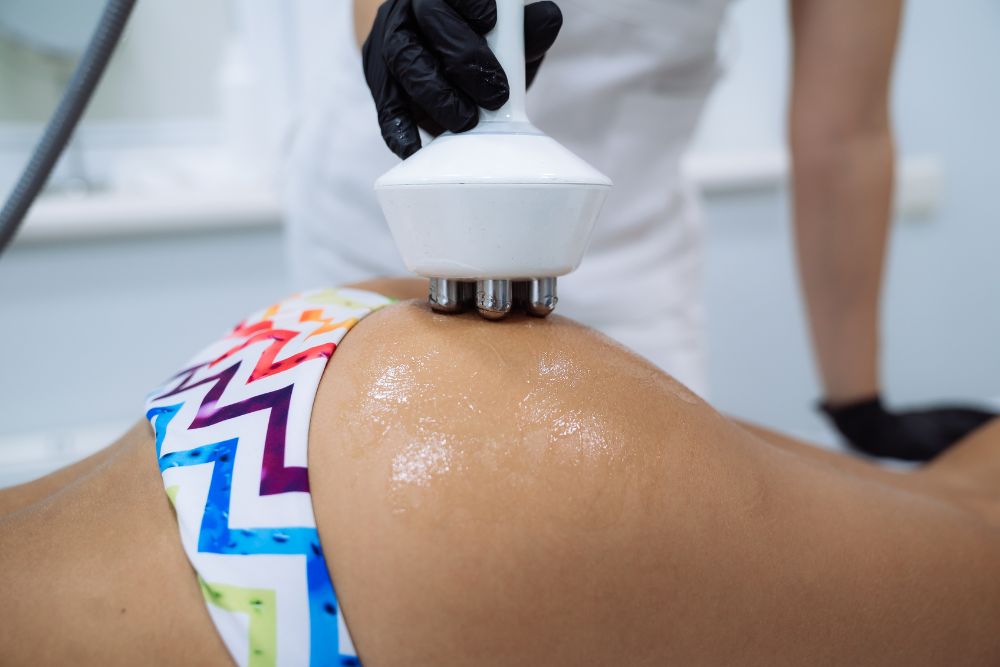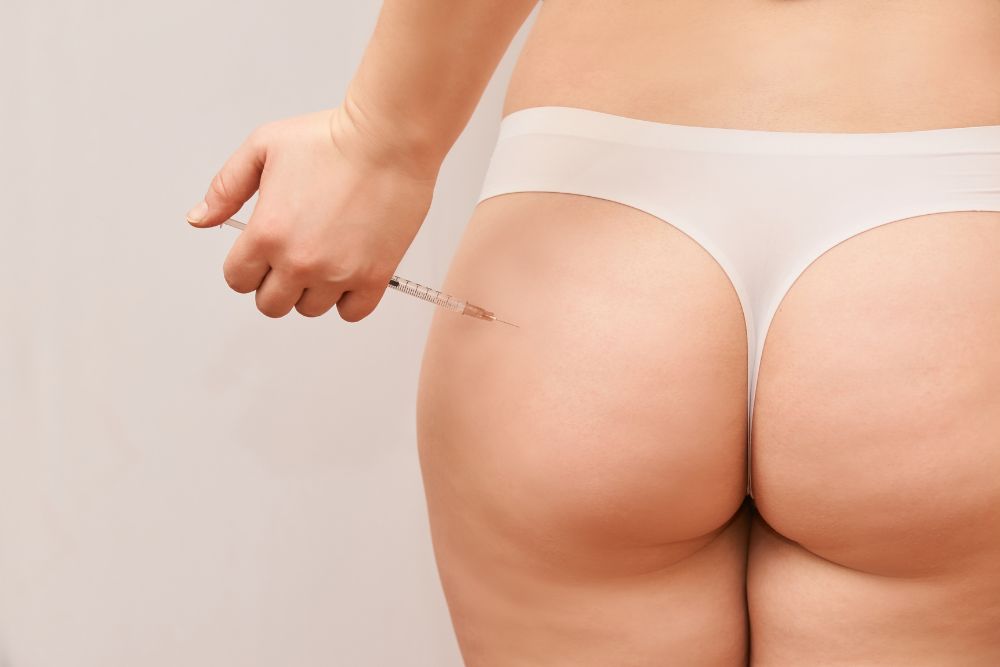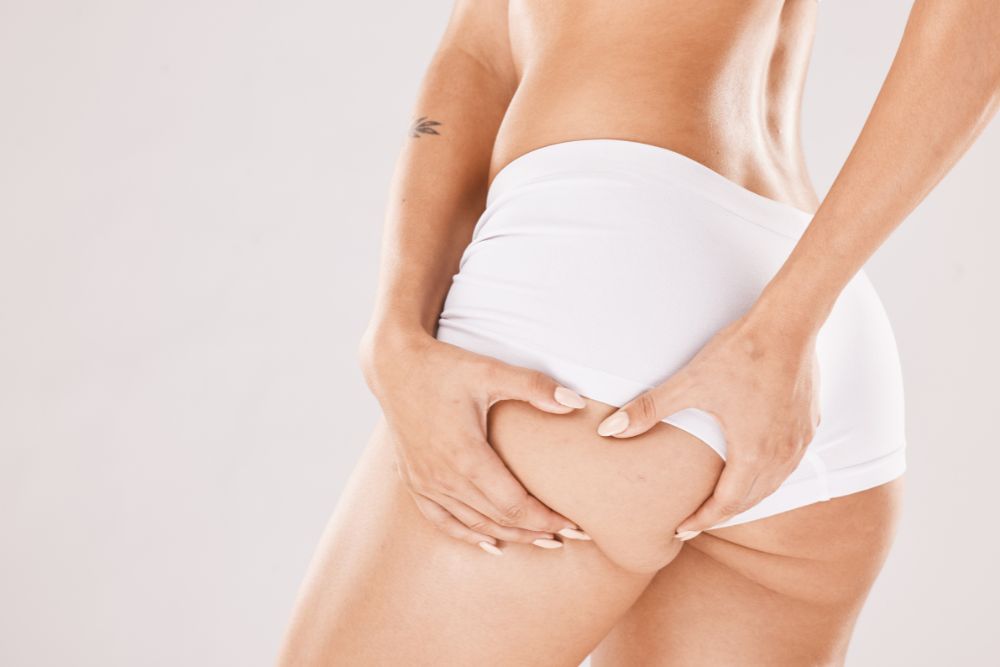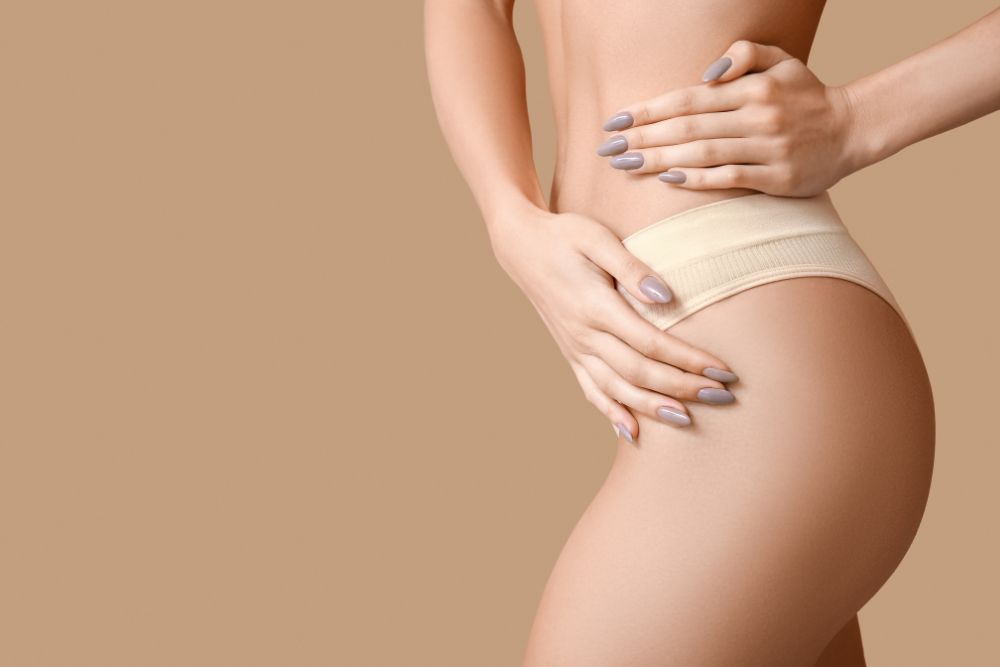What is a Brazilian Butt Lift?
A Brazilian butt lift (BBL) is a popular cosmetic procedure designed to enhance the shape and volume of the buttocks. Unlike traditional buttock implants, which involve inserting silicone implants, a BBL uses the patient’s own fat through a process known as fat transfer to achieve a more natural look and feel. This fat is harvested from other areas of the body, such as the abdomen, thighs, or flanks, through liposuction. Once purified, the fat is carefully injected into various areas of the buttocks to create a fuller, more aesthetically pleasing contour.
The appeal of a BBL lies in its dual benefits: not only does it enhance the buttocks, but it also slims down the areas where the fat was removed, creating a more balanced and proportionate overall appearance. This procedure is ideal for individuals seeking a more curvaceous figure without the use of synthetic materials.
The Brazilian Butt Lift Procedure
 The Brazilian butt lift is a complex procedure that typically takes between 2 to 3 hours to complete. BBL surgery is usually performed under general anesthesia, although some surgeons may use IV sedation. The process begins with the surgeon making small incisions in the areas designated for fat removal, such as the abdomen, thighs, or flanks. A cannula, a thin tube-like instrument, is then inserted to suction out the fat using a technique called liposuction.
The Brazilian butt lift is a complex procedure that typically takes between 2 to 3 hours to complete. BBL surgery is usually performed under general anesthesia, although some surgeons may use IV sedation. The process begins with the surgeon making small incisions in the areas designated for fat removal, such as the abdomen, thighs, or flanks. A cannula, a thin tube-like instrument, is then inserted to suction out the fat using a technique called liposuction.
Once the fat has been harvested, it undergoes a purification process to remove any impurities, such as blood, oil, or damaged fat cells. This step is crucial as only the healthiest fat cells are used for the fat transfer procedure, ensuring the best possible outcome.
After purification, the surgeon strategically injects the fat into different layers of the buttocks to create a smooth, even contour. The surgeon may make hundreds of tiny injections to ensure that the injected fat is evenly distributed and that the final result looks natural. The procedure concludes with the closure of the incisions and the application of a compression garment to help with swelling and support the newly shaped buttocks.
Understanding Fat Cell Retention
 One of the key factors that determine the longevity of a Brazilian butt lift is the survival of the fat cells transferred. When fat is transferred to the buttocks, not all of it will survive. It is common for the body to reabsorb a certain percentage of the transferred fat cells, typically within the first few weeks following the procedure. This is a natural part of the healing process and is accounted for by the surgeon during the procedure.
One of the key factors that determine the longevity of a Brazilian butt lift is the survival of the fat cells transferred. When fat is transferred to the buttocks, not all of it will survive. It is common for the body to reabsorb a certain percentage of the transferred fat cells, typically within the first few weeks following the procedure. This is a natural part of the healing process and is accounted for by the surgeon during the procedure.
On average, patients can expect to retain about 60-80% of the transferred fat. The surviving fat cells are permanent and will continue to behave like fat cells in other parts of the body. This means they can expand or contract with weight gain or loss, which can affect the shape and size of the buttocks over time.
Several factors can influence fat cell retention, including the patient’s overall health, the surgeon’s technique, and the aftercare provided during the recovery period. Maintaining a stable weight, following a healthy diet, and adhering to post-operative instructions are essential for maximizing fat retention and ensuring long-lasting results.
Recovery and Aftercare
 Recovery from a Brazilian butt lift is a critical phase that can significantly impact the longevity of the results. The initial recovery period typically lasts 2 to 3 weeks, during which time patients must take special care to avoid sitting directly on their buttocks or lying on their back. Establishing a stable blood supply is essential for the survival and integration of the newly transferred fat cells. This is crucial because placing pressure on the buttocks can compromise the survival of the newly transferred fat cells.
Recovery from a Brazilian butt lift is a critical phase that can significantly impact the longevity of the results. The initial recovery period typically lasts 2 to 3 weeks, during which time patients must take special care to avoid sitting directly on their buttocks or lying on their back. Establishing a stable blood supply is essential for the survival and integration of the newly transferred fat cells. This is crucial because placing pressure on the buttocks can compromise the survival of the newly transferred fat cells.
To help manage discomfort, patients may be prescribed pain medication. Swelling, bruising, and some degree of discomfort are common during the first few weeks, but these symptoms should gradually subside. Patients are often advised to wear a compression garment to minimize swelling and support the healing process.
Adopting a healthy lifestyle is also important during recovery. A balanced diet rich in nutrients supports healing, while regular exercise, once cleared by the surgeon, helps maintain overall health and the appearance of the buttocks. However, it’s important to avoid strenuous activities and heavy lifting until fully recovered.
Maximizing Results
 Achieving optimal results from a Brazilian butt lift requires more than just the procedure itself; it also depends on the patient’s commitment to maintaining their results. Here are some tips to maximize the longevity of your BBL:
Achieving optimal results from a Brazilian butt lift requires more than just the procedure itself; it also depends on the patient’s commitment to maintaining their results. Here are some tips to maximize the longevity of your BBL:
-
Maintain a Stable Weight: Significant weight fluctuations can alter the appearance of your buttocks. Gaining or losing weight can cause the fat cells to expand or shrink, potentially changing the shape and volume of your buttocks.
-
Follow a Healthy Diet: A diet rich in lean proteins, healthy fats, and whole grains can support the healing process and help maintain your results. Staying hydrated is also important for overall health and skin elasticity.
-
Avoid Smoking: Smoking can negatively impact the healing process by reducing blood flow to the treated areas, which can affect the survival of the transferred fat cells.
-
Exercise Regularly: Once you have fully recovered, regular exercise can help maintain your new figure. Focus on exercises that tone the muscles in your lower body, such as squats and lunges, to enhance your buttocks’ appearance.
-
Follow Post-Operative Instructions: Adhering to your surgeon’s post-operative care instructions is crucial. This includes wearing compression garments, attending follow-up appointments, and avoiding activities that could compromise your results.
-
Consider Weight Management: Gaining too much weight after your BBL can lead to undesired fat distribution, affecting the shape of your buttocks. Conversely, some individuals may need to gain weight to qualify for the procedure. In such cases, focus on nutritious options to help increase caloric intake.
Long-Term Results of Brazilian Butt Lifts
 The long-term results of a Brazilian butt lift can be quite satisfying, with many patients enjoying their enhanced appearance for years. However, it’s important to note that while a Brazilian Butt Lift (BBL) enhances the size and shape of the buttocks through fat transfer, it does not address the issue of excess skin. Individuals concerned with excess skin in the buttock area should consider alternative procedures like thigh and buttock lift surgery as a more appropriate solution. However, it’s important to understand that while the results can be long-lasting, they are not necessarily permanent. Several factors can influence the longevity of your results:
The long-term results of a Brazilian butt lift can be quite satisfying, with many patients enjoying their enhanced appearance for years. However, it’s important to note that while a Brazilian Butt Lift (BBL) enhances the size and shape of the buttocks through fat transfer, it does not address the issue of excess skin. Individuals concerned with excess skin in the buttock area should consider alternative procedures like thigh and buttock lift surgery as a more appropriate solution. However, it’s important to understand that while the results can be long-lasting, they are not necessarily permanent. Several factors can influence the longevity of your results:
-
Aging: As you age, your skin naturally loses elasticity, which can affect the appearance of your buttocks. While the transferred fat cells are permanent, the overlying skin may sag over time, altering the contour of your buttocks.
-
Weight Fluctuations: As mentioned earlier, significant changes in weight can impact the size and shape of your buttocks. To preserve your results, it’s important to maintain a stable weight.
-
Lifestyle Factors: Habits such as smoking and excessive sun exposure can negatively affect the longevity of your results. Smoking impairs blood circulation, while sun exposure can damage the skin’s elasticity, both of which can alter the appearance of your buttocks.
Factors that Affect the Longevity of Results
Several factors can influence how long your Brazilian butt lift results last:
-
Weight Gain or Loss: Since the transferred fat cells behave like any other fat cells in your body, gaining or losing weight will affect their size and, consequently, the appearance of your buttocks.
-
Aging: The natural aging process can cause the skin to lose its firmness and elasticity, which can impact the shape and size of your buttocks over time.
-
Lifestyle Habits: Smoking, poor diet, and lack of exercise can all negatively impact the longevity of your results. These factors can affect skin elasticity, overall health, and fat cell retention.
Risks and Complications of the Brazilian Butt Lift Procedure
Like any surgical procedure, a Brazilian butt lift carries risks and potential complications. It is important to be aware of these risks and discuss them with your surgeon before deciding to undergo the procedure. Establishing a stable blood supply for the transferred fat cells is crucial for their survival and integration into the body. Some of the potential risks include:
-
Infection: As with any surgery, there is a risk of infection. Proper aftercare and following your surgeon’s instructions can help minimize this risk.
-
Fat Embolism: A rare but serious complication, fat embolism occurs when fat enters the bloodstream and blocks a blood vessel. This can be life-threatening and requires immediate medical attention.
-
Scarring: While the incisions made during liposuction are small, there is still a risk of scarring. The visibility of scars depends on factors such as skin type, healing process, and the surgeon’s technique.
-
Asymmetry: There is a possibility that the buttocks may not be perfectly symmetrical after the procedure. This can occur due to uneven fat absorption or the natural differences in the body.
While a Brazilian Butt Lift (BBL) enhances the size and shape of the buttocks through fat transfer, it does not address the issue of excess skin. Individuals concerned with excess skin in the buttock area should consider alternative procedures like thigh and buttock lift surgery as a more appropriate solution.
What to Expect During the Healing Process
Understanding what to expect during the healing process can help you prepare for your recovery and ensure a smoother experience. Here’s a general timeline of what to expect:
-
Week 1: You will likely experience significant swelling, bruising, and discomfort. It’s important to avoid sitting or lying directly on your buttocks. Pain medication will be prescribed to manage discomfort.
-
Weeks 2-3: Swelling and bruising will begin to subside. You should continue to avoid putting pressure on your buttocks and wear a compression garment as instructed by your surgeon.
-
Weeks 4-6: You may gradually start to resume normal activities, but strenuous exercise and heavy lifting should still be avoided. Your surgeon will provide guidance on when it’s safe to do so.
Returning to Normal Activities
Most patients can return to light activities within 2 to 3 weeks after surgery. However, it’s important to avoid any activities that put direct pressure on your buttocks, such as sitting for long periods, heavy lifting, or strenuous exercise. These activities can compromise the results and affect fat cell retention.
Your surgeon will provide specific instructions on when you can return to your regular routine. It’s important to follow these instructions carefully to ensure a successful recovery and long-lasting results.
Touch-Up Procedures
In some cases, touch-up procedures may be necessary to maintain or enhance the results of your Brazilian butt lift. These procedures can address any asymmetry or irregularities that may develop over time. Touch-ups may involve additional fat grafting or other cosmetic treatments to refine the appearance of the buttocks.
It’s important to discuss the possibility of touch-up procedures with your surgeon during your initial consultation. Understanding this aspect of the procedure can help you make an informed decision and set realistic
FAQ: Brazilian Butt Lift (BBL) Longevity
1. How long do the results of a Brazilian Butt Lift typically last?
The results of a Brazilian Butt Lift can last for many years, but they are not permanent. The longevity of your BBL results depends on several factors, including fat retention, lifestyle habits, and aging. On average, most patients enjoy their enhanced appearance for 5 to 10 years or longer.
2. Will I lose some of the fat after the procedure?
Yes, it’s normal to lose a certain percentage of the fat cells transferred within the first few weeks after the procedure. Typically, about 60-80% of the transferred fat survives and becomes permanent. The fat that does survive will remain in place as long as you maintain a stable weight.
3. Can weight gain or loss affect my BBL results?
Absolutely. Because the transferred fat cells behave like regular fat cells, significant weight gain can cause them to expand, potentially increasing the size of your buttocks. Conversely, weight loss can cause the fat cells to shrink, reducing the volume and altering the shape of your buttocks.
4. Is it possible to sit down after a Brazilian Butt Lift?
During the initial recovery period (typically 2-3 weeks), you should avoid sitting directly on your buttocks to prevent putting pressure on the newly transferred fat cells. After this period, your surgeon will guide you on when and how you can sit safely.
5. What can I do to ensure the best possible long-term results?
To ensure the best possible long-term results, it’s important to maintain a stable weight, follow a healthy diet, avoid smoking, and adhere to your surgeon’s post-operative instructions. Wearing compression garments as recommended and avoiding direct pressure on your buttocks during recovery are also crucial.
6. Are touch-up procedures common after a BBL?
Touch-up procedures are not uncommon and may be needed to refine or maintain the results of your BBL. This can include additional fat grafting or other cosmetic treatments to address any asymmetry or volume loss that may occur over time.
7. What are the risks associated with a Brazilian Butt Lift?
The risks associated with a BBL include infection, fat embolism, scarring, and asymmetry. Fat embolism, though rare, is a serious complication that can be life-threatening. It’s important to discuss all potential risks with your surgeon before undergoing the procedure.
8. How soon can I return to exercise after a Brazilian Butt Lift?
You should avoid strenuous exercise and heavy lifting for at least 6 to 8 weeks after your surgery. Light activities can typically be resumed within 2 to 3 weeks, but your surgeon will provide specific guidelines based on your recovery progress.
9. Can the results of a BBL be reversed?
The results of a BBL are permanent, meaning the transferred fat cells will remain in place as long as you maintain a stable weight. However, significant weight loss can reduce the size of your buttocks. If you’re unhappy with your results, consult your surgeon to discuss possible corrective procedures.
10. How much fat is typically transferred during a Brazilian Butt Lift?
The amount of fat transferred during a BBL varies depending on the patient’s body and desired outcome. Generally, surgeons aim to transfer enough fat to create a noticeable enhancement while considering the body’s ability to sustain the transferred fat. This can range from a few hundred cc’s to more than a liter, depending on the case.
By understanding the Brazilian Butt Lift procedure, recovery process, and factors that influence long-term results, patients can make informed decisions and take the necessary steps to maximize their outcomes. Always consult with a qualified plastic surgeon to discuss your goals and expectations before undergoing a BBL.

